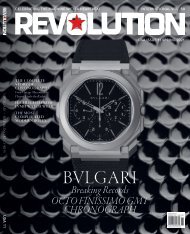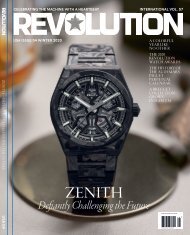You also want an ePaper? Increase the reach of your titles
YUMPU automatically turns print PDFs into web optimized ePapers that Google loves.
LA GRANDE<br />
DAME<br />
As Grand Seiko celebrates its 60th anniversary this year,<br />
the brand pays tribute to some of its greatest hits with a<br />
slew of new offerings.<br />
WORDS DARREN HO, SUMIT NAG & FELIX SCHOLZ<br />
The Seiko company was first founded in 1881 by<br />
Kintaro Hattori as an importer of fine quality watch<br />
and jewelry products, and post-incorporation<br />
in 1892, Mr Hattori soon began to develop Japanese<br />
watchmaking, believing that the country’s craftsmen would<br />
be capable of making sophisticated timekeepers. As Daini<br />
Seikosha and Suwa Seikosha began producing watches<br />
under various names, in the ’60s they began to focus on<br />
developing fine chronometers that were comparable to Swiss<br />
precision performers. Like any Asian student competing<br />
against foreigners, their diligent study efforts soon paid off,<br />
and they quickly caught up with their Swiss peers.<br />
However, the development of beautiful watchmaking<br />
isn’t merely innate performance; the exterior is just as<br />
significant. Up till the ’50s, Seiko didn’t have a design ideas<br />
department until 1958. When Mr Taro Tanaka was hired in<br />
1959, it marked the first step in the transformation of the<br />
brand. Mr Tanaka would go on to develop a complete set of<br />
rules for Grand Seiko and the discontinued King Seiko’s<br />
collection, a system of design that remains within the Seiko<br />
organization’s guidelines.<br />
The rules reflected the style of watch design popular in<br />
the era, and to this day, still guides the industry at large. The<br />
global perception of luxury and precious products overall<br />
has changed very little. However, the very first Grand Seiko<br />
released in 1960, with a stated chronometer precision<br />
of -3/+12 seconds a day held on to classic Seiko looks —<br />
rounded, angled lugs on a round case with a thin bezel;<br />
dauphine hands and faceted hour markers, brushed or softly<br />
polished surfaces.<br />
The said reference, the 3180, bore a caliber of the<br />
same number, with 25 jewels and a reserve of 45 hours. The<br />
words ‘Grand Seiko’, in a stylized font, were applied on the<br />
dial, a marked difference from later models which bore the<br />
‘GS’ abbreviation. The case back bore the symbol of a lion,<br />
Seiko’s emblematic creature and the case was in gold. A few<br />
models were later produced in full platinum.<br />
GRAND SEIKO AT 60<br />
Grand Seiko’s rise in the industry since has been nothing<br />
short of meteoric. Both in terms of performance, as well as<br />
design and stylistics, the brand’s original cult following has<br />
gone mainstream. Today, it’s coveted both among those who<br />
love high-end watchmaking, as well as those who appreciate<br />
the Japanese style of aesthetics and design, a utilitarian<br />
mode of watchmaking, coupled with traditional crafts.<br />
It’s a trend that Grand Seiko itself has noticed and<br />
played up. Last year, the brand released the SBGZ001,<br />
with a snowflake-pattern dial and case in platinum that<br />
was handworked by artisans of the Micro Artist Studio<br />
in Shiojiri. The matte, irregular pattern gave the watch<br />
a startlingly distinct look that was incredibly sexy and<br />
sophisticated, demonstrated by how quickly the watch sold<br />
out even at a rather steep price of USD70,000.<br />
This year marks Grand Seiko’s 60th anniversary,<br />
and the company’s released a bevy of new models that<br />
are targeted at both new and old, classic and sporty<br />
watch buyers. The stars of this year’s 60th anniversary<br />
celebrations are the Elegance SBGW257, 258 and 259<br />
references, a trio of Grand Seikos that are loyal to the<br />
reference 3180 in looks. Angled polished surfaces play<br />
against the mirror-finished case and bezel surfaces, as<br />
well as around the sapphire case back, through which<br />
one can admire the 9S64 manually-wound caliber.<br />
The movement, first introduced in 2011, featured a<br />
SPRON alloy (a material developed by Seiko<br />
for its hairspring, the 610, and mainspring, the 510)<br />
which is less likely to deform and has greater tensile<br />
performance, so it can deliver better isochronism<br />
and store more energy for release in the movement.<br />
The escape wheel and pallet fork are also manufactured<br />
with Micro Electro Mechanical Systems (MEMS) and are<br />
designed to allow them to hold lubricating oil better. The<br />
movement delivers a three-day power reserve in the slim<br />
watch, which is sized at a more era-appropriate 38mm,<br />
compared with the 3180’s 35mm.<br />
Three models of the watch have been produced: the<br />
first in platinum, sunray-brushed dial with gold faceted<br />
markers and dauphine hands; the second in yellow gold with<br />
a white dial; and the final model in Brilliant Hard Titanium,<br />
a material that’s exclusive to Grand Seiko. The enhanced<br />
material has twice the hardness of steel with the weight<br />
of titanium, and is also more lustrous than regular-grade<br />
titanium, which makes the watch’s Zaratsu polished surface<br />
appear even more brilliant than usual. The watch comes in a<br />
Grand Seiko blue dial.<br />
100 BACKTOTHEFUTURE











